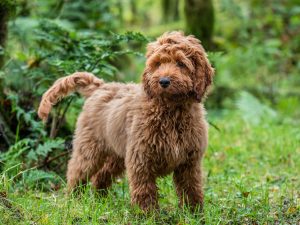Cockapoo
Breed description

Pros
- Friendly and happy dogs
- Love human company
- Generally trainable nature
Cons
- Require a moderate amount of exercise
- Susceptibility to some health conditions
- Require some coat care
Suitable for
The Cockapoo makes a great family dog, it’s happy to join you on a long countryside walk, and equally as content to curl up on its bed and sleep. These dogs do thrive with human company and interaction, making them great companions for dog agility and even as therapy dogs. The Cockapoo doesn’t need hours of exercise each day, but a minimum of an hour’s activity is needed to keep them happy and their energy levels in check.
- Retired couples looking for a bright, happy companion
- Families with or without children
- Medium sized so ideally a home with a garden
These lovely dogs can make great family companions, their happy attitudes and trainability can make them a wonderful addition to any family.
Breed care advice
The Cockapoos coat shouldn’t shed much, but it does vary between individuals. The curly nature does mean that it requires a bit of upkeep, to prevent it getting matted and uncomfortable. Daily brushing can avoid this, and a regular trim can also help dogs stay cool and neat. Something to bear in mind given that these dogs do tend to enjoy sniffing their way through the hedgerows and getting pretty grubby!
As with all young dogs, the puppies can be mischievous. Early training is advisable to teach appropriate toys and avoid any unwanted chewing behaviour that could lead to them swallowing things they shouldn’t. This is also why appropriate human contact is necessary, these dogs thrive on interaction and such behaviours can arise when they’re not given enough stimulation.
Known health problems
Many lines of both Cocker Spaniel and Poodle have tendencies to develop atopic dermatitis – this is an underlying hypersensitivity of the skin that leads to chronic itching, secondary skin infections, and frequently results in sequelae such as hair loss and skin thickening. This can’t be ignored when faced with the Cockapoo, and it’s not surprising that we frequently see these dogs for similar skin complaints too. Ear disease such as inflammation of the external ear canal (otitis externa) is also common. This is owing to their rather hairy ear canals, which create an ideal, sweaty environment for secondary infection. Many Cockapoos with otitis externa will also have more generalised skin disease such as food allergy dermatitis and atopic dermatitis as well.
As with the Labradoodle, both parent breeds are susceptible to inherited eye disorders. These can include hereditary cataracts (HC) where clouding and opacification of the lens leads to blindness, as well as glaucoma (increased pressure within the eye that can lead to pain and blindness) and retinal dysplasia (an abnormal retina causes vision impairment). There are some genetic tests available to help select Poodle and Cocker Spaniel parents that aren’t affected by such conditions, so as to reduce the chance of the Cockapoo puppies inheriting them.
- Skin and ear disease
- Non-neoplastic anal sac disease – a significant number of Cockerpoos have anal sac irritation or infection that isn’t due to tumour processes but which may occur concurrently with other disorders like allergic skin disease
- Eye problems – such as HC, glaucoma and retinal dysplasia
Lead author: Yvette Bell MRCVS